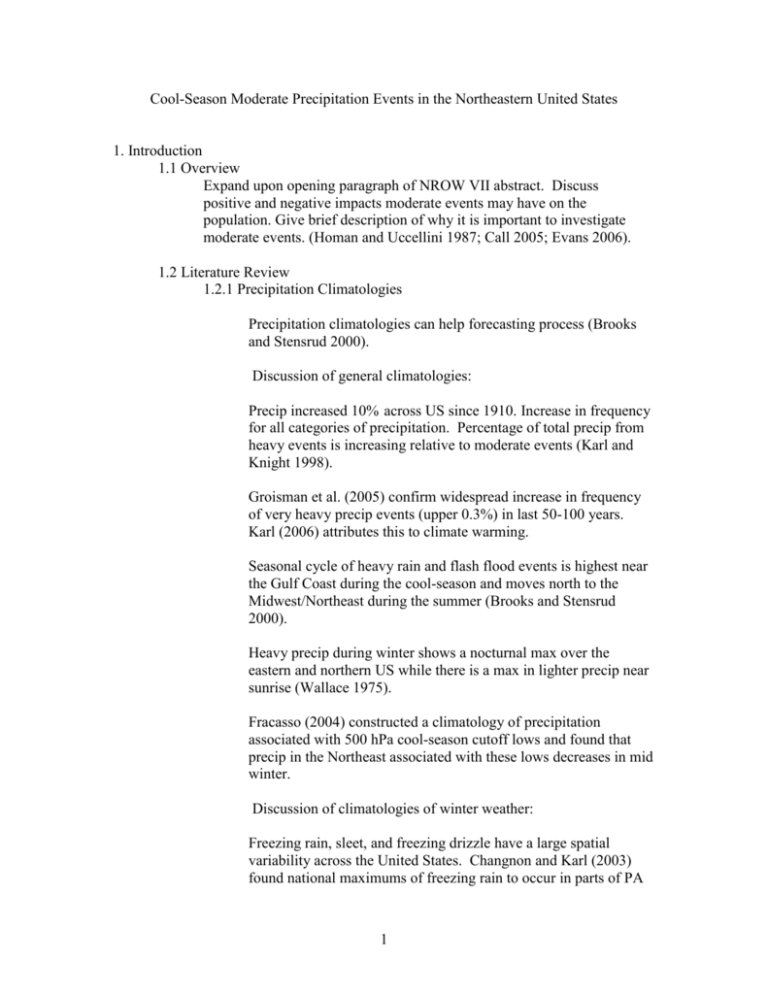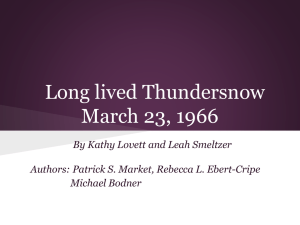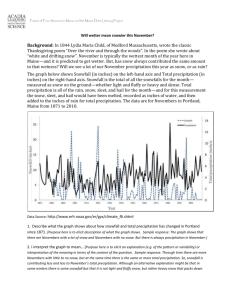Thesis outline
advertisement

Cool-Season Moderate Precipitation Events in the Northeastern United States 1. Introduction 1.1 Overview Expand upon opening paragraph of NROW VII abstract. Discuss positive and negative impacts moderate events may have on the population. Give brief description of why it is important to investigate moderate events. (Homan and Uccellini 1987; Call 2005; Evans 2006). 1.2 Literature Review 1.2.1 Precipitation Climatologies Precipitation climatologies can help forecasting process (Brooks and Stensrud 2000). Discussion of general climatologies: Precip increased 10% across US since 1910. Increase in frequency for all categories of precipitation. Percentage of total precip from heavy events is increasing relative to moderate events (Karl and Knight 1998). Groisman et al. (2005) confirm widespread increase in frequency of very heavy precip events (upper 0.3%) in last 50-100 years. Karl (2006) attributes this to climate warming. Seasonal cycle of heavy rain and flash flood events is highest near the Gulf Coast during the cool-season and moves north to the Midwest/Northeast during the summer (Brooks and Stensrud 2000). Heavy precip during winter shows a nocturnal max over the eastern and northern US while there is a max in lighter precip near sunrise (Wallace 1975). Fracasso (2004) constructed a climatology of precipitation associated with 500 hPa cool-season cutoff lows and found that precip in the Northeast associated with these lows decreases in mid winter. Discussion of climatologies of winter weather: Freezing rain, sleet, and freezing drizzle have a large spatial variability across the United States. Changnon and Karl (2003) found national maximums of freezing rain to occur in parts of PA 1 and NY, the Midwest, eastern Appalachains, and the Pacific Northwest. Cortinas et al. (2004) show the distribution of freezing precip is affected by topography, proximity to water, and the synoptic storm track. Several snow/winter cyclone climatologies available. Colucci (1976) looked at winter cyclone tracks and found highest concentration in a band from Cape Hatteras to New England and over the eastern Great Lakes (Fig. 1: important for my climatology results). Businger et al. (1990) constructed a storm following climatology and found the frequency of moderate-heavy precip was highest north of the low. Novak et al. (2004) produced a climatology of heavy banded snowfall in the Northeast and found that most heavy events were associated with banding northwest of the surface low. Branick (1997) constructed a detailed climatology of significant winter weather events across the US. He found a yearly mean of 128 significant events somewhere across the US (eventually relate this to the frequency of moderate events occurring at each site). He also found a max frequency of events from late November to late January with a sharp rise from October to November (similar to trends seen in my moderate events). 1.2.2 Mechanisms for producing precipitation 3 main mechanisms for producing precip: moisture, lift, instability (e.g. Doswell et al. 1996). 1.2.2.1 Moisture Importance of moisture noted in all case studies (e.g., Homan and Uccellini 1987) Nicosia and Grumm (1999); Jurewicz and Evans (2004)). Instabilities not released if air is too dry. (I will not say more than a short paragraph on moisture). 1.2.2.2 Lifting mechanisms Brief discussion of the QG omega equation and Q vector omega equation from Holton (1992). Quick look at how QG omega equation can be reanalyzed into form where vertical motion is assessed by geopotential height and thickness contours (Trenberth 1978). Use of Q vectors by Gyakum (1987) to diagnose vertical velocity. QG forcing plays a role in affecting strength and depth of frontal circulations (Jurewicz and Evans 2004). Transition to frontal forcing….. 2 Definition of Petterssen 2D frontogenesis and how it works (Bluestein Vol. 2 1993; Nicosia and Grumm 1999). Present an alternative way to express it (Moore and Blakely 1988; Moore et al. 2005;). Discuss how frontogenesis leads to a vertical circulation (Sawyer 1956, Sanders and Bosart 1985). 1.2.2.3 Instability Definitions and applications of gravitational (convective), inertial, and symmetric instabilities (Schultz and Schumacher 1999; Sanders and Bosart 1985, Fig 4; Seltzer et al. 1985). Discuss a special kind of symmetric instability, CSI (S and S 1999). Give origins of the CSI theory (Bennetts and Hoskins 1979; Emanuel 1979; Emanuel 1983a,b; Snook 1992) and methods to analyze it (e.g. Moore and Lambert 1993; Wiesmueller and Zubrick 1998). Discuss atmospheric criteria that can result in CSI (Wiesmueller and Zubrick 1998). Make sure to show that CSI and slantwise convection are not the same thing. CSI is the instability, the other is the result of CSI being released (S and S 1999). Present an easier method to diagnose CSI called the equivalent potential vorticity (EPV) (Moore and Lambert 1993). Show how this is properly used to diagnose CSI by using the saturated form (EPV*) (S and S 1999; Jurewicz and Evans 2004). McCann (1995) presents a 3D version of EPV that relates EPV to vertical and horizontal temperature gradients. Discuss how CSI can coexist with conditional instability, but with CI dominating (Moore and Lambert 1993). Snook (1992) states that EPV determines the potential of CSI regardless of the geostrophic wind shear, but be sure to note that in order to determine CSI vs. CI, EPV needs to be used in conjunction with the old method of CSI analysis. Show S and S (1999) fig. 4. Emanuel (1985, Fig. 5) shows that the vertical circulation around a frontal zone, when in the presence of negative EPV* or even weakly positive symmetric stability (or EPV*), is concentrated and enhanced on the warm side of the frontogenesis max. These results are confirmed by Thorpe and Emanuel (1985). Similarly, Xu (1989) shows that frontogenesis in the presence of negative EPV can produce long lasting mesoscale bands. Will show how this applies to some past case studies in upcoming subsection. 1.2.3 Ingredients based methodology (IBM) 3 Potential benefits of an IBM (Wetzel and Martin 2001; Doswell et al. 1996). Ingredients based methodology using the above ingredients for deep convection, severe thunderstorms, and cylogenesis: moisture, lift, instability (McNulty 1978, 1995; Doswell 1987, Johns and Doswell 1992). Doswell et al. (1996) developed an IBM for flash flooding that accounts for previous hydrological conditions, total precipitation, precipitation rate, and duration. An IBM for cloud heads, a precursor of rapid cyclogenesis, was developed by Dixon et al. (2002). Their Vertically integrated extent of Realizable Symmetric instability (VRS) diagnostics included negative EPV*, high moisture, and strong vertical motion. IBM for snowfall developed by Nietfeld and Kennedy (1998) assumes air temperature, snowfall rate, and snowfall duration are the three main ingredients. This did not have much operational utility. Janish et al. (1996) use an IBM for diagnosing the distribution of winter weather precipitation type through the use of composite charts. S and S (1999) develop an IBM for slantwise convection. Wetzel and Martin (2001) expand upon the concepts of Janish et al. (1996). They determine five key ingredients for a winter precipitation event as being QG forcing for ascent, moisture, instability, precipitation efficiency, and temperature. The first 3 ingredients have been discussed in detail above. Brief description of cloud microphysics that produce heavy snow. Discuss ice crystal habits and show that dendrites have the lowest density (Power et al. 1964; Roebber et al. 2003). Show that high accumulations result from large snowflakes consisting of dendritic crystals where the max vertical motion occurs around −15 °C (Mossop 1970; Auer and White 1982; Rogers and Yau 1989). Give a very brief description of temperature influence (Wetzel and Martin 2001). Discuss some traditional operational forecast techniques that apply some ingredients of the above IBMs. Goree and Younkin (1966) used a synoptic climatology method to find favored areas of snow in relation to the 500 hPa vorticity max and surface low, while Browne and Younkin (1970) related snowfall to the track of the 850 hPa low. Cook (1980) showed that snow totals over the next 24-h would be roughly equal to the 200 hPa warm advection in °C during that period. Wetzel (2000) summarized the Garcia method, in which Garcia found that the 12 hour snowfall in inches equals twice the average mixing ratio on an isentropic surface that 4 intersects the forecast area between 700 and 750 hPa. Garcia (2000) updated his initial method to allow for high snow/liquid ratios and jet streak events. A “magic chart” was developed by Sangster and Jagler (1985) which relates snowfall amounts to the net vertical displacement of an air parcel over a 12-h period ending 24-hours after that parcel arrives at 700 hPa. Finally, Gordon (1998) developed a winter weather checklist in which he describes the LEMO technique, which relates snow totals to the speed of the absolute vorticity max. 1.2.4 Heavy snow in the presence or absence of an intense cyclone. Give a very brief discussion of classic eastern US cyclogenesis as described by Kocin and Uccellini (1990, 2004) and Maglaras et al. (1995). Show how jet stream interactions can lead to enhanced snow during such events (Uccellini and Kocin 1987). State that the ingredients above usually come together best in cyclones such as these. 1.2.4.1 Application of some ingredients to intense cyclones Brief introduction to precipitation structure within a cyclone (Bjerknes 1919). Show that heavy bands are often present to the northwest of the cyclone (Novak et al. 2004). Sanders (1986) found that lower tropospheric frontogenesis occurs in the banded region northwest of the surface low. Wiesmueller and Zubrick (1998) showed that frontogenetic forcing can make a region more prone to CSI. Sanders and Bosart (1985) confirmed in their case study the results from Emanuel (1985) that maximum ascent occurs in a band parallel to the axis of frontogenesis. The ageostrophic circulation around the frontogenesis max is narrowed and intensified in the presence of weak symmetric stability (WSS) (or CSI). Reuter and Yau (1990) offer evidence to show that slantwise convection is not a rare phenomenon as seven events occurred in a three month period near Nova Scotia. Several observational studies of bands within classic cyclones have found this to be true, as well as confirming the results of Emanuel (1985): (Seltzer et al. 1985; Wiesmueller and Zubrick 1998; Nicosia and Grumm 1999; Novak et al. 2004; Jurewicz and Evans 2004). 1.2.4.2 Application of ingredients to weak or nonexistent surface lows Observations also show that heavy snow can occur without a strong surface low or even with no surface low at all (Seltzer et al. 1985; Moore and Blakely 1998; Jurewicz and Evans 2004; Novak et al. 2004; Moore et al. 2005 (show their Fig. 15b); Evans 2006). 5 Each of these studies found that the collocation of a sloping frontogenetical circulation in the presence of CSI or weak moist symmetric stability can lead to heavy snow just as in the classic cases described above. Novak et al. (2004) and Jurewicz and Evans (2004) showed in their cases with lower QPF that the frontogenetical forcing was weaker and less sloped. Gyakum (1987) and Homan and Uccellini (1987) looked at the problems associated with forecasting light to moderate snow events. Gyakum (1987) studied an unforecasted moderate snow event that was not associated with a surface cyclone or obvious front and found that it resulted from a thermally direct frontal circulation in a region of weak MSS. 1.3 Research goals and thesis synopsis Show that the above literature review has discussed mechanisms for producing precipitation, especially in winter storms. State that the systems studied in this research are more like those of Gyakum (1987) and Homan and Uccellini (1987). To that end, the goals of this research are to 1) construct a climatology of cool-season moderate precipitation events in the Northeast and 2) determine the synoptic-scale and mesoscale features that determine when and where these events occur. The second goal will be accomplished using components of the IBM’s above and applying them in a manner as discussed by the above case studies for heavy snow. Present the organization of the rest of the thesis: Chapter 1: Overview and Literature Review; Chapter 2: data and methodology; Chapter 3: climatology results; Chapter 4: Case study results; Chapter 5: discussion and forecast implications; Chapter 6: summary and future work. 2. Data and Methodology 2.1 Data sources 2.1.1 Climatology Data were obtained from NCDC’s Local Climatological Data LCD and Hourly Preciptation Data (HPD). Discuss problem with some missing data (especially snowfall), but note that it is a minor issue. 2.1.2 Case Studies Cases were selected based on the criteria that the event total precipitation at most stations were in the moderate range and that the precipitation was not obviously associated with a deep cyclone. 6 Data were used from several sources. All case studies made use of the 40-km Eta model, available at 3-h intervals, and displayed using the NWS Albany and Binghamton Weather Event Simulator (WES) version 4.0. Data for some large scale analysis was also obtained from NCEP/NCAR Reanalysis data at a 2.5° x 2.5° resolution. Radar data are from NCDC archives. Soundings provided by the University of Wyoming. 2.2 Methodology 2.2.1 Climatology Define the domain boundary and discuss the 1st order station selection process. Define cool season. Present criteria for a moderate event. Show how daily data were used to identify a moderate event. Show how hourly data were used to refine the case selection process for potentially ambiguous cases. Histograms were produced similar to those of Cortinas et al. (2004) to show the distribution of moderate events by city, state, and geographic region. 2.2.2 Case Studies Define the equation used by WES for Q-vector divergence (Holton 1992). Define Petterssen frontogenesis as calculated by WES (Bluestein 1993; Nicosia and Grumm 1999) and show why it is better to use the real wind for this calculation. Define EPV from Moore and Lambert (1993) and EPV* from S and S (1999) and Jurewicz and Evans (2004) as calculated by WES. Going against the recommendations of S and S (1999), Jurewicz and Evans (2004) give some reasons as to why the real wind should be used in calculating EPV*. Determined that three types of systems often produce moderate events during the cool season across the Northeast: Alberta Clippers (Hutchinson 1995), weak Ohio Valley warm-advection lows (as in Homan and Uccellini 1987), and inverted troughs Keshishian and Bosart 1987, Keshishian et al. 1994). These were the basic storm types chosen for study. Plan view maps were produced for each case study to assess the synoptic situation. Examples include sea level pressure, 500 hPa geopotential heights and vorticty, 1000–500 hPa thickness, upper- 7 level (~ 250 hPa) heights and winds, and low-level Q vector forcing and the corresponding omega. Soundings were used for locations near the precipitation to determine the thermodynamic influence on the precipitation. Cross sections were created for each case study to analyze the mesoscale impacts on the observed precipitation. Cross sections were taken through the precipitation region according to the methods described in section 1.2.2.3 in order to analyze various aspects of moisture, instability (either CSI or CI via EPV* and momentum-theta e), and lift (through frontogenetical forcing). 3. Climatology results 3.1 Seasonal trends Show how there appear to be two distinct minima for many of the 35 stations: one in October and another in February. There also appear to be distinct peaks that occur during late autumn/early winter and again as spring arrives. Present several histograms to illustrate this point. 3.2 Geographic trends ERI had the most events over the last 10 years (197) while BWI had the least (95). The histograms show that far more moderate events occurred over the northern, western, and Great Lakes regions of the domain than over the southern and eastern regions. The Atlantic coastal regions had the lowest overall frequency of occurrence. The high terrain had a frequency of occurrence at or slightly above the mean. Present histograms for New York State and other geographic regions. Compare and contrast the stations with others in that region and in different geographic regions. Show contour map of ratio of number of events at each site to the mean number of events for all sites. 4. Case studies 4.1 Overview 4.2 27 December 2004 Forecast for ALB called for very light snow with the main system well off to the southeast. Instead, over 15 cm of snow fell. 8 4.2.1 Synoptic overview Deep cyclone well off the Atlantic Coast continuing to move off the coast. Weak inverted trough over the Northeast. Some QG forcing was present. A moderate band of snow developed over Albany producing over 15 cm of snow. Show maps that illustrate synoptic set up. 4.2.2. Mesoscale aspects Weak, shallow region of frontogenesis and a flat, shallow region of negative EPV* results in a modest region of vertical motion. Thin layer of instability is CI, not CSI. 4.3 8 January 2005 Forecast for BUF called for a chance of snow showers with accumulations under 3 cm from a weak system passing by to the south. Instead, nearly three times that much snow fell. 4.3.1 Synoptic overview A weak Ohio Valley low pressure with associated warm advection and some wrap-around precipitation affected much of New York state. QG forcing was present. Snow totals ranged from around 7.5 cm in BUF to just under 15 cm in ALB. Some mixing occurred in the main warm advection region near BGM, which resulted in lower snowfall totals. Show maps illustrating synoptic set up. 4.3.2 Mesoscale aspects Frontogenesis similar to 26 December case: weak and shallow slope. Layer of instability was slightly deeper, but some of this may have been caused by rapid drying with height as seen in the cross section. 4.4 26 January 2005 This case was chosen to see how the mesoscale aspects of an Alberta Clipper compare with heavier events since Clippers often have relatively strong synoptic forcing and have less available moisture. 4.4.1 Synoptic overview An Alberta clipper dropped down across the eastern Great Lakes and into New York State. Synoptic forcing was present in the form of Q-vector convergence and vorticity advection. Snow totals were in the 7–13 cm range across the state. Show synoptic maps. 9 4.4.2 Mesoscale aspects Frontogenetical circulation a bit stronger in this case than previous two cases. A double frontogenesis max is noted. The max farther south was in a fairly stable region, while the northern most max (near ALB) was able to tap into a region of WSS. The frontogenesis max is still not as intense or upright as the heavy events discussed in the lit review, so the snow totals are much lower. The quick movement of the system also helped cut down on totals. 4.5 21 February 2005 This case was chosen because it had fairly strong synoptic and mesoscale forcing. The speed of the system may have resulted in lower snow totals. 4.5.1 Synoptic overview This case is not covered in as much detail as the other three. A weak low and its associated warm advection moved eastward across New York State. Snow broke out in the warm advection region across eastern New York and New England. Good synoptic forcing was present. Snow totals were in the 7.5–15 cm range. 4.5.2 Mesoscale aspects Fairly strong, upright region of frontogenesis and associated region of upward motion is present. This region of frontogenesis is also associated with a deep region of negative EPV* and WSS. Radar confirms that the precipitation band moved through rather quickly. 5. Discussion and forecast implications 5.1 Climatology Discuss possible reasons for the observed seasonal distribution. For example, more Alberta Clippers occur around January, and perhaps more lake effect events in December and January. The March and April peak probably requires further study. The fact that February has two or three fewer days cannot explain the decrease in the frequency of events over the 10 year period. There would have to be a moderate event on almost every day that was missed to account for the difference. In order to discuss the topic of geographic distribution, the figure showing the ratio of the number of events at each station to the mean number of events will be revisited. The peaks in the northern and western sections could be explained by Alberta Clippers and lake effect precipitation. Also many Ohio Valley lows spread moderate precipitation across this region. Show how lake effect snow has a way of eliminating itself, although it is not explicitly excluded, as seen in the figure. The high terrain peak may be a 10 result of orographic enhancement of otherwise light events. Also, the minimum along the Atlantic Coast and southeastern portion of the domain may be related to the cyclone storm track discussed by Colucci (1976). The storm track would suggest that during the cool season, a larger percentage of storms along the coast are heavy events. 5.2 Case studies Show how the synoptic scale was conducive for precipitation to develop in all four cases. The first three cases all exhibit similar frontal scale circulations and instability patterns. The key point is that the frontogenesis is not as strong or upright in these moderate cases as was seen in heavy snow cases. Therefore, even in the presence of a region of CI or WMSS, the resulting circulation is not as intense. Thus we see weaker updrafts and less intense precipitation. It appears that the depth of the unstable region is only a modulating effect, while it is the frontogenetical circulation that is driving the precipitation. The third case, which had more intense and upright frontogenesis, was still not as upright as heavier events. The quick movement of the system also plays a role in limiting precipitation, as evidenced by the fourth case. Therefore, it appears that moderate events have similar ingredients as heavier events. Synoptic forcing is present. There is a region of frontogenesis, a layer of instability or WMSS, and sufficient moisture, but these features are not as deep, upright, or well aligned as in heavier events. These features will be shown in a schematic cross section of moderate events. The features also appear to be more transient than they are in the northwest region of a classic intense cyclone. The strength, depth, tilt, and speed of these features has major implications for forecasters, as they can now recognize that these hard-to-forecast moderate events have similar structures as more familiar heavy events, but just to a lesser degree. 6. Summary and suggestions for future work Tie up loose ends and summarize key findings from the climatology and case studies. Offer suggestions for future work: 1. Expand the climatology to include a longer time period 2. Use data from COOP stations to provide a more detailed climatology 3. Determine what type of system caused each moderate event and apply the event type to the climatology results. 4. Apply the techniques used here to other moderate events to see if similar results are obtained. 5. See what differences apply to null cases where moderate precipitation was forecasted but never materialized. 11 Fig. 1.1 Winter cyclone frequencies for January 1964–December 1973. Contour values should be multiplied by 10. From Colucci (1976). 12 Fig 1.2. Schematic vertical cross section illustrating symmetric instability. Solid lines represent absolute momentum, M, while dashed lines represent equivalent potential temperature. Letters show sample displacements (dashed) and accelerations (arrows). From Sanders and Bosart (1985). 13 Fig 1.3. Stability regimes often observed near frontal zones. Contours represent typical values often present: Mg (thick black lines) and θ*e (thin gray lines). From Schultz and Schumacher (1999). 14 Fig. 1.4. Vertical cross section of the circulation around a sloping frontal zone (dashed line) in the presence of vanishing potential vorticity in the warm air (to the right of the frontal zone). From Emanuel (1985). 15 Fig. 1.5. Cross section through a heavy snow band depicting strong, sloped frontogenesis (solid contours), saturation equivalent potential temperature (dashed contours), and saturation equivalent potential vorticity (negative values shaded). 12-hr forecast valid at 0000 UTC 5 February 1995. From Nicosia and Grumm (1999). 16 Fig 1.6. Schematic cross section (Moore et al. 2005) through a heavy snowband showing steeply sloped midlevel frontogenesis (solid purple ellipse) and conditionally unstable region (dashed blue line). Region of WMSS is shaded. 17







